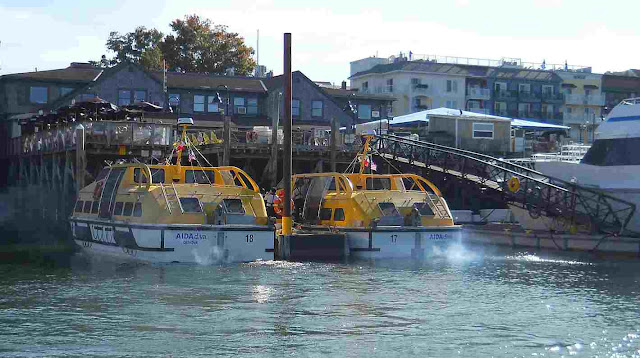Reporter Steve Betts of the Rockland Maine Courier Gazette writes a half-baked cruise industry puff piece., that quotes not a single concerned citizen which spewing many column inches of quotes from a handful of businesses that benefit from then. Sure a few clumsy paraphrases, but all in all so badly written that you can't help but think he plans to market it - or a barely modified version - to the cruise ship industry's magazine market.
By Stephen Betts | Nov 02, 2017
ROCKLAND — The large cruise ships that arrive in Rockland have been met with resistance by some citizens, who claim that these vessels pose environmental risks to the region, harm lobstermen by damaging traps, and bring little economic benefit to the city.
But a closer examination of these issues finds that there is little evidence to back up those arguments. Downtown business owners said this week that they see a spike in business when the large cruise ships arrive.
Ann Hoppe, owner and manager of Puffin's Nest, said the visits by the cruise ships provide a great benefit to her business. "There's a lot of foot traffic and lots of sales," Hoppe said. "The passengers love Rockland. They are tickled to be here."
Charla Prescott of the Rockland Cafe said the restaurant experiences a significant benefit when the cruise ships are in the harbor. "We get a ton of revenues," Prescott said.
Sierra Dietz, owner of the Grasshopper Shop, said the business sees about a 50 percent increase when the large cruise ships are in town. She said these visits help her keep staff employed longer in the fall and allow her to invest money back into the community.
Frank Albert of Frank's Family Hair Care said he gave five haircuts to passengers from each of the two past large cruise ships that arrived in Rockland. He said that if this occurs on future visits, he would earn up to $100 more per day.
Albert said he also sees firsthand the economic benefit from large cruise ship visits. "Unquestionably there is a benefit. I see the passengers walk by with packages and they tell me they eat at local restaurants," he said.
Lynn Archer of the Brass Compass and Archer's on the Pier restaurants said there is a huge positive impact to her businesses when the large cruise ships are in port. "They're a huge boon for business," Archer said.
The Penosbcot Bay Regional Chamber of Commerce released statistics for six large cruise ships that arrived in September and October. Of the 9,728 passengers combined from those vessels, 28 percent took a bus trip shore excursion that went to Camden (Mount Battie as well as downtown Camden), the Owls Head Transportation Museum, and the Coastal Maine Botanical Gardens in Boothbay.
The chamber pointed out that the remaining passengers remained in Rockland. Even those who took the bus trips returned to spend some hours in Rockland.
Environmental
Some residents have expressed concern about the potential environmental harm that the large cruise ships pose to Rockland and adjoining waters. But according to wastewater treatment specialists, that is not a concern.
Rockland Wastewater Treatment Director Terry Pinto said the ships have treatment systems on board that are superior to what Rockland has. The large cruise ships discharge their treated wastewater at least 12 miles offshore and the water discharged meets drinking water regulations.
City officials toured the Norwegian Gem when it was in port last month. City Manager Tom Luttrell said in a manager's report last month that recyclables and other certain wastes are unloaded from the ship in New York City after each seven-day cruise. Certain food wastes are shredded into fine particles and dumped overboard when the ship is 12 miles offshore.
Lobster harvesting gear
Yet another criticism of the large cruise ships is that they damage traps as they travel into Rockland Harbor. Maine Marine Patrol Sgt. Matthew Talbot said he has not had any reports this year of lobster gear being damaged by cruise ships.
He said in past years there have been some reports, but that the damage was not solely from cruise ships but also ferries, large yachts and the barge that carries cement out of Rockland. He said competing uses of the waters result in such incidents.
Large cruise ships have been targeted for criticism for much of the current decade. In March 2010, the Rockland Harbor Management Commission made a presentation to the City Council.
The report from the Harbor Management Commission stated that Bar Harbor and Portland have had a host of issues with the "mega cruise ships." Some of those concerns include environmental impacts, such as diesel engines that "spew exhaust equivalent to 10,000 cars," ocean currents that bring discharged sewage dumped three miles at sea to the shore, and pollution that negatively affects the lobster industry.
The commission also stated that studies have shown that local residents often avoid areas and businesses during peak shore visits in some towns and are "apt to avoid downtown at all times for fear a ship will be in port."
Business owners have not reported hearing of any local residents avoiding their shops on the few days that cruise ships are in town.
The commission also stated in 2010 that another concern of these other communities was an increase in crime. There are again no statistics or anecdotal reports to back up that claim in Rockland.
"We want to be clear that we are not saying no to cruise ships; we are just requesting that the council take a careful and thoughtful look at the reality of the impact on our small town," the commission stated at the time.
Some of the concerns expressed in 2010 have also been voiced more than seven years later, but without any concrete facts to support them.


















